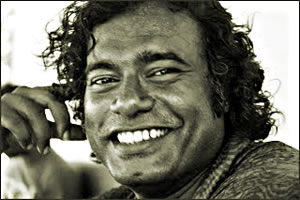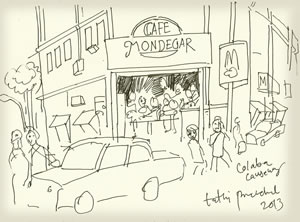 We asked the Delhi based art critic, writer, curator and translator about his experiences .
We asked the Delhi based art critic, writer, curator and translator about his experiences .
Here’s Johny ML’s take on travel and experience
Travel Deal: Which is your favorite travel destination? And why?
JohnyML: Favorite destinations change depending on the nature of traveling. I am not a person bitten by travel bug. But I do travel a lot as a part of my work. When it comes to traveling for pure enjoyment Kanya Kumari is a place I would like to visit again and again. Known to the rest of the world as Cape Comerin, Kanya Kumari is a place where three oceans, the Bay of Bengal, the Indian Ocean and the Arabian Sea meet. It is the southern tip of India. This place is nostalgically connected with me as there used to be annual family visits to this place during my childhood. Kanyakumari Temple, Vivekananda Rock and Thiruvalluvar Statue are the major attractions. Though the nature of seashore has changed over a period of time, I still look for those small crabs running along the shore and hiding in small holes, differently colored sands and shells. This is my favorite destination because I find some amount of peace in this place. Besides, on the way to Kanya Kumari, one could visit Sucheedram Temple and Padmanabhapuram Palace with wonderful murals. Both the bus and train journeys to Kanyakumari from Trivandrum are refreshing as the landscape along the way is really interesting.
TD: What’s your favorite street food?
JML: When I travel South, I prefer to eat from Tattukadas, makeshift eateries that become active only by evening. These eateries are different from dhabas of the North. Tattukadas serve you with good dosas, idlis, fish fries and many other vegetarian and non-vegetarian delicacies. I like to eat parottas and mutton fry from these shops.
TD: What’s your memorable journey?
JML: Most of the journeys are memorable ones. Traveling from Bastar to Narayanpura in Chattisgarh is one such memorable journey. Naraynpura is a Maoist center. We drove from Bastar to meet a tribal sculptor living in the Naxal region. We were advised to return by sunset by the Army deployment. Somehow we could not make it by that time. As we drove back it was pitch dark. The forests on either side had Mahua trees that yielded flowers with alcoholic contents. Tribal people set fire under each tree during the flowering season. We witnessed a vast land with trees circled by the girdles of fire. It was thrilling though we were partly benumbed by the fear of a possible Maoist attack on our vehicle.
TD: Could you narrate one of your funny travel experiences?
JML:When you are in it, no experience is a funny experience. But in retrospection they could look funny. I would rather recollect a happy and touching experience. Once I was traveling from Delhi to Kerala by train. A person from Lakshadweep befriended me during the journey. He was helping everyone in the train, to collect water, to fetch food or any chores like that. I got curious and he narrated his story to me. In an island everyone helps everyone else. That was the lesson I learnt from him. I recounted this experience in an article which got published in a very popular magazine in Kerala. A few weeks later, when I went to book my ticket back to Delhi, a booking clerk at the window, after looking at my application form asked me whether I was the same person who wrote about a guy from Lakshadweep. I said yes. Then he told me that the same person had come to book the ticket a week before at the same counter and they had talked about my article. This remains a very happy and touching experience in my journeys so far.
TD: Where does your work take you often?
JML: Work often takes me to Mumbai and Ahmedabad. In Mumbai I work with galleries and artists and in Ahmedabad I teach in two academies, National Institute of Design and CEPT University respectively. I enjoy spending time in Mumbai because in this city you could be simply anonymous. I walk into galleries, see shows, go to Samovar Restaurant at the Jehangir Gallery and occasionally meet some familiar people. I like Mumbai as a destination though I do prefer to live in Delhi.
TD: What is your take on art and travel?
JML: Somewhere I have written that travel is always filled with the unexpected even if it is a chartered one. Absolute strangers come up to help you or you meet up with people whose life stories could change your perspective. If you are an art/culture person, you are inclined to look out for such things during your journey. Travels reveal the characteristic features of the places where you travel and character of each place is constituted by the living cultures; it could be traditional as well as contemporary. You could read the people by looking at the images in the public domain. Artists and art people should travel as it is integral for developing and enriching their experiences and world view.
TD: Which is your get away place where you want to spend time alone?
JML: When you are not traveling, it is always my study room. But when I am traveling, I wish to spend time in small temples and or near temple ponds. I do not call it meditation but such places give you some kind of calmness. My experience is that I could go blank in such places. My favorite get away place is Sabarmati Ashram in Ahmedabad. Whenever I get a chance I go there and sit for a long time. I just think about Mahatma Gandhi and his days there. Perhaps, I always like to live my life in an ashram, devoting myself completely to reading, writing, meeting people and listening to them.
TD:How does travelling help you as an art critic? Does travel help you in understanding art better?How?
JML: As I mentioned before, I am not an avid traveler like many others in our art scene. But travelling does help me expand the scope of my experience about contemporary art and history. I speak less and listen to artists a lot. I speak only when I am asked to speak. Whenever I travel, I try to visit the studios of artists and listen a lot from them. Listening to their version of art is always important to formulate a critical idea about the art scene which you are writing about. If at all I have learnt any lesson from my traveling it is this: each person out there has a story worth listening to. Each artist has potential and an interesting life. But I gauge their life with their ambitions, aspirations and philosophy; and most of them fall flat in my eyes when I come to know that they are more keen on certain ideas about ‘success’ than the art they produce which could take them to that ‘success.’ Really good artists do not talk about success or opportunities. They talk about their art and success naturally comes to them.


